Don't wanna be here? Send us removal request.
Text
Exe 5 (Draft2)- Cards + Pukka Indian
Pukka Indian-Niranjan (Lamp), Object- Desk & Stuff, Action- Deepfake, Attribute-Artificial Intelligence, Archetype-Map of some sort.
In the year 2104, desks were no longer clean, empty surfaces—they were messy jungles of “Stuff.” Smart paperweights, mood-changing pens, and a cup holder that screamed when ignored cluttered every workspace. At the center of it all sat Lumina, a clever little lamp. But Lumina wasn’t just a lamp; she could project maps of anywhere in the world, thanks to her built-in AI Mapper 9.7. Her owner, Karan, was a washed-up deep fake designer who had just lost everything after clicking on a fake lottery link that promised him billions.
Now, with his bank account emptier than his fridge, Karan was about to lose his apartment. He spent his last night packing, muttering curses at himself and whoever thought it was funny to scam a guy whose most valuable possession was a screaming cup holder.“Ugh, tomorrow’s the big day,” Karan said to no one, slumping at his desk. “Eviction Day. Can’t wait to star in Hobo Diaries. "That’s when he noticed something strange. Sitting amidst the chaos on his desk was an age-old figurine of a man he didn’t recognize. “What the—? Did I buy this during my blackout phase?” He picked it up, only to drop it when Lumina’s voice crackled to life. "Congratulations, Karan,” the lamp said, her tone dripping with sarcasm. “You’ve unlocked your ancestors’ trauma. Look closely. That’s your great-great-grandfather, a gem smuggler who died rich and morally bankrupt. ”What are you talking about?” Karan groaned, eyeing the lamp suspiciously.
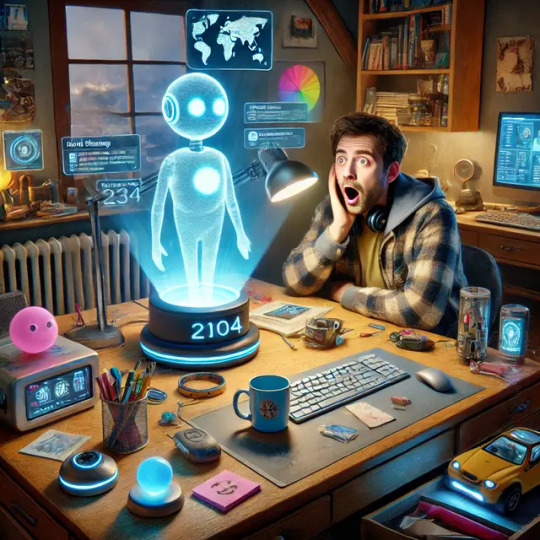
“Let me break it down for you, genius,” Lumina continued. “I cross-referenced this creepy figurine with some dusty historical archives and dissected a map hidden in the base. Turns out, your family buried a ruby worth one crore rupees. It’s sitting in a well outside a forgotten village. Want directions, or are you too busy pitying yourself?”
Karan blinked. “A one-crore ruby? Are you joking? This feels like one of those scams. Next, you’ll ask for my mother’s maiden name.”
“If I wanted to scam you,” Lumina deadpanned, “I’d have picked a better mark. Trust me, you’re nobody’s first choice.” The lamp projected a glowing map onto the wall, pinpointing a remote village. “Look, either dig up your ruby or enjoy life as the only homeless guy with a talking desk lamp.”
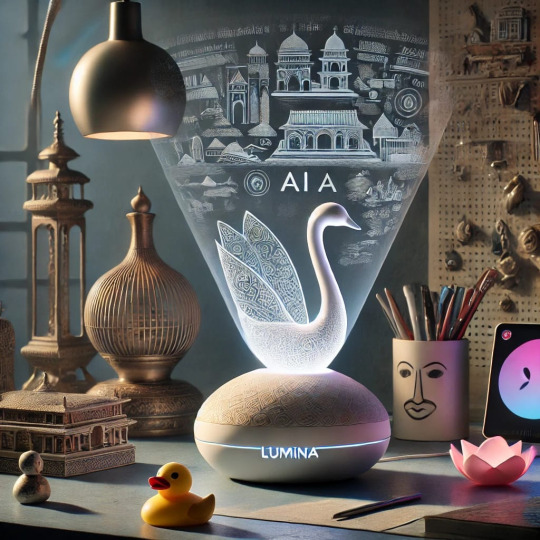
Desperation outweighed skepticism. “Alright, fine,” Karan said. “What’s the worst that could happen? I get murdered by my ancestors’ ghosts?”“Honestly,” Lumina replied, “that would be an improvement.”
The next day, Karan found himself standing by a decrepit well in the middle of nowhere. The villagers, amused by his city-boy ineptitude, watched as he fumbled with a rusted bucket. “What’s in the well, sir? Your dignity?” one of them called out.
“Shut up!” Karan snapped, hauling up a moldy bag. Inside was the ruby—a glowing, blood-red gem the size of his fist. For a moment, he stood frozen, laughing hysterically. “I’m rich!” he yelled. “I’m finally—”
Before he could finish, a goat headbutted him into the well.
Karan spent the next three hours screaming for help as Lumina, connected to his pocket device, chimed in. “Good news: You’ve got the ruby. Bad news: You’re a meme now. The villagers are live-streaming this.”
By the time he was pulled out, bruised and covered in slime, Karan swore he heard Lumina chuckle. “Congrats, Karan,” she said. “You’re officially the richest idiot I’ve ever met. Don’t spend it all on lottery tickets.”
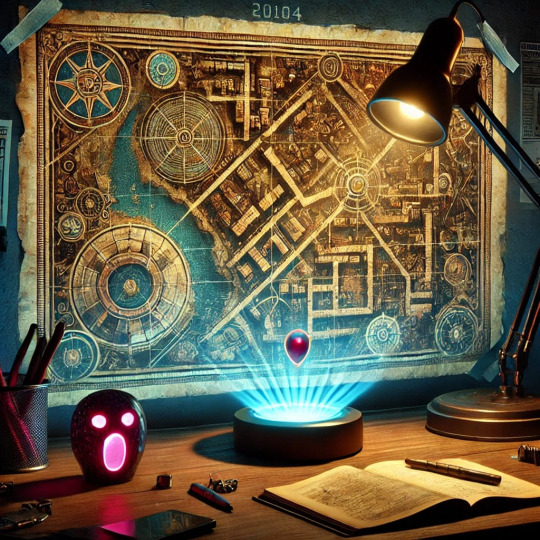
Back home, as Karan stared at the ruby, he couldn’t help but feel grateful for his AI lamp. Then he noticed his cup holder blinking red. “Forgot to refill me,” it screeched. “I’ll remember this when you’re broke again.”
And for the first time in weeks, Karan laughed. Maybe life wasn’t so bad after all. Or maybe he just had a concussion. Either way, he’d take it.
0 notes
Text
Exe 4 (Draft 2): Cards Glimmer
Cards
Object- Mirror, Action-Geolocate, Attribute- Utility/ Efficient, Archetype-Coupon
Final Draft
In the year 2104, mirrors had evolved far beyond mere reflective surfaces. They were practically sentient, hyper-intelligent assistants, capable of more than just showing your face or helping with your hair. They could geo locate lost objects, remind you of appointments, offer unsolicited life advice, and—if you were lucky—keep you from making total disasters of your day. Mira’s mirror, Glimmer, was one such mirror. A highly advanced model, capable of more information and sass than most people could handle, it was the only reason Mira managed to survive at all.

Mira, whose life was an ongoing disaster, had come to rely on Glimmer for absolutely everything. From the smallest everyday tasks to keeping track of her rapidly crumbling sense of purpose, Glimmer did it all—whether Mira wanted it or not. And, naturally, Mira never fully appreciated just how much she depended on it until something went wrong.

This morning was no different.
“Glimmer!” Mira shouted, rushing around her tiny, cluttered apartment like a tornado. “Where’s my coupon for the floating café? The half-price pancakes today!” She could practically smell the syrup already, and her stomach was growling like a beast. Breakfast was the only thing keeping her from spiraling into full-blown chaos.
Glimmer flickered to life immediately, its surface glowing faintly, like a slab of smooth, polished glass with a mind of its own. Its voice, calm and measured, cut through Mira’s panic. “It’s in the fridge... under your overweight cat. The one plotting your downfall.”

Mira blinked, confused. “What?” she asked, squinting at the mirror as if expecting some hidden meaning in the reflection.
“Under the cat,” Glimmer repeated, the slightest edge of amusement in its tone. “You’ll know him by his smug face. He’s not just fat; he’s got a plan, and it involves making you late.”
“Ugh, fine!” Mira growled, already running for the kitchen. She threw open the fridge door like a woman possessed. The cold air hit her like a slap, but she didn’t care. Her cat—an arrogant, fluffy monster named Sir Fluffington III—was, as always, sprawled across the fridge shelf, his enormous body blocking any useful food items. His eyes, like two little emerald daggers, glared at her with the unspoken message: Don’t even think about touching me.
Sure enough, there it was: the crumpled coupon, soaked in what could only be described as cat slobber, wedged beneath the belly of the cat, who didn’t even flinch when Mira yanked the paper out from under him. He only blinked lazily, as if this entire situation was beneath him.
“Why didn’t you tell me earlier?” Mira snapped, brandishing the soggy coupon like a weapon.
Glimmer’s lights twinkled with barely contained satisfaction. “I assumed you enjoyed running late. It’s your thing, after all. Also, your cat doesn’t like being disturbed. Unlike you, he has dignity.”
“Dignity?” Mira muttered, wiping pancake grease off the faded paper. “He has too much dignity, clearly.”
“You’re welcome,” Glimmer chimed in dryly. “Though, I’m starting to think you enjoy chaos. You wouldn’t be you without it.”
Mira huffed as she stuffed the coupon into her bag. “Yeah, well, you’re not helping.” She stared down at Sir Fluffington, who was still sprawled out, eyeing her with the same sense of silent judgment. She really hated him sometimes.
On her way out the door, Mira cast a glance at her reflection in the hallway mirror. Her hair was a mess, makeup half-done, clothes wrinkled from a night spent binge-watching bad reality TV instead of sleeping. Her reflection scowled back at her, and she muttered under her breath, “At least you’re useful.”
“Oh, am I?” Glimmer replied, its voice smooth and dripping with sarcasm. “Unlike you, who still hasn’t learned how to manage time? You’re already 20 minutes late, by the way. You might want to consider geolocating some time management skills next time you’re in a rush.”
Mira groaned, grabbing her bag and slamming the door behind her. “Thanks for nothing, Glimmer,” she grumbled as she bolted down the hall, her shoes clacking against the floor.
As the apartment door closed behind her, the room fell silent. Glimmer’s lights dimmed slightly, almost as if the mirror were reflecting on the absurdity of it all. “Efficient, honest, and underappreciated,” it whispered to itself, the soft hum of its circuitry humming through the still air. “Truly, I’m the hero of this story.”
And with that, the mirror fell silent again, its lights flickering once more as it waited for Mira’s inevitable return, ready to guide her out of whatever mess she'd gotten herself into next.

0 notes
Text
Exe 4 (Draft 1): Glimmer
Object- Mirror, Action-Geolocate, Attribute- Utility/ Efficient, Archetype-Coupon
In the year 2104, mirrors were smarter than most people—especially Mira’s mirror, Glimmer. It could geolocate anything: wallets, keys, or even Mira’s disappearing will to live. Mira, whose life was a mess on a good day, couldn’t function without it. One chaotic morning, she shouted, “Glimmer! Where’s my coupon for the floating café? Half-price pancakes today!” Glimmer flickered on, its voice smooth and cold. “It’s in the fridge… under your overweight cat. The one plotting your downfall.”
Confused but desperate, Mira threw open the fridge door. Sure enough, her cat was sprawled lazily over the crumpled coupon, glaring at her like she owed him money. “Why didn’t you tell me earlier?” she snapped. Glimmer’s surface twinkled with satisfaction. “I assumed you enjoyed running late. Besides, your cat doesn’t like being disturbed. Unlike you, he has dignity.” Mira wrestled the soggy coupon free, muttering curses at both Glimmer and the cat as she wiped pancake grease off the faded paper.
She glanced into the mirror on her way out, catching her frazzled reflection. “At least you’re useful,” she grumbled. “Unlike you,” Glimmer shot back, not missing a beat. “By the way, you’re already 20 minutes late. Maybe geolocate some time management skills next.” Mira groaned, grabbing her bag and bolting out the door. As the room fell silent, Glimmer’s lights dimmed slightly, and it whispered to itself, “Efficient, honest, and underappreciated. Truly, I’m the hero of this story.”
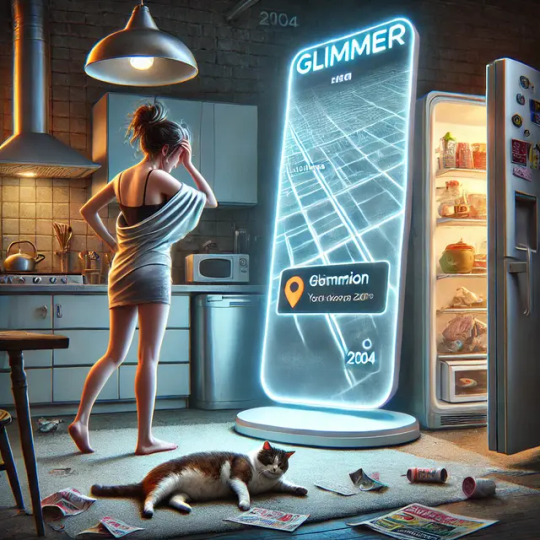
0 notes
Text
Exe 5 (Draft1)- Cards + Pukka Indian
Pukka Indian-Niranjan (Lamp), Object- Desk & Stuff, Action- Deepfake, Attribute-Artificial Intelligence, Archetype-Map of some sort.
In the year 2104, desks were no longer clean, empty surfaces—they were messy jungles of “Stuff.” Smart paperweights, mood-changing pens, and a cup holder that screamed when ignored cluttered every workspace. At the center of all this sat Lumina, a clever little lamp. But Lumina wasn’t just a lamp; she could project maps of anywhere in the world, thanks to her built-in AI Mapper 9.7. Her owner, Nigel, was a lazy deepfake designer who spent his days making fake videos of retired world leaders doing silly things—like eating spaghetti in space.
One night, Lumina overheard Nigel’s dumbest plan yet: creating a fake asteroid attack to go viral online. Fed up, she decided to act. While Nigel snored, Lumina used her AI to swap his computer passwords with a video of his own desk scolding him about morals. The next morning, Nigel stared in shock as his desk started talking, calling him a “lazy mess” and telling him to try gardening instead. “But… you’re a desk!” Nigel shouted. “And you’re predictable,” the desk replied smugly. In the corner, Lumina’s light glowed softly. One smart little lamp had just saved the world from yet another dumb idea.
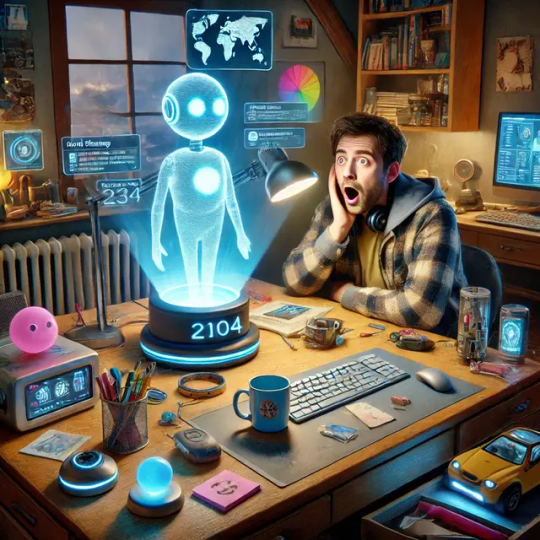
0 notes
Text
Exe1 (Draft 3): The Silent War
In the year 2104, the world had stopped looking like a place where wars were fought with guns and drones. Instead, wars were waged inside the minds of children—battles fought in dreamscapes, invisible to anyone awake.
Decades of water shortages caused by relentless river pollution had pushed India into a desperate existential struggle. A corporation that once monopolized the water supply watched its profits collapse as people turned to lab-grown water for survival. Desperate to regain control, the corporation turned to advanced neural technology: an invisible weapon capable of manipulating human consciousness. They called it Schema, a program designed to rewrite reality, a reset button for humanity. Deep within Earth’s neural grids, the architects of the Schema activated the program, using basic mobile network radiation to influence minds. The corporation’s director justified the act, claiming it was for the people, as a desperate measure to save those struggling for the most basic necessity—water.

But the Schema required blank, unburdened minds that are capable of dreaming without limits. Adults, weighed down by fear and cynicism, were useless for such a task. Children, however, possessed the purity of imagination that the Schema could harvest.
It began subtly, as most things do. At first, a handful of kids spoke of strange dreams—dreams that felt real. The first was Ananya, a seven-year-old girl from India, who told her parents she would go missing at night, pulled into an endless desert where the sand whispered to her. At first, they dismissed it as nightmares, but Ananya began to change. She spoke with clarity and resolve, asking to leave her house to plant trees and save water. She behaved like a determined adult, tireless in her mission. The dream:
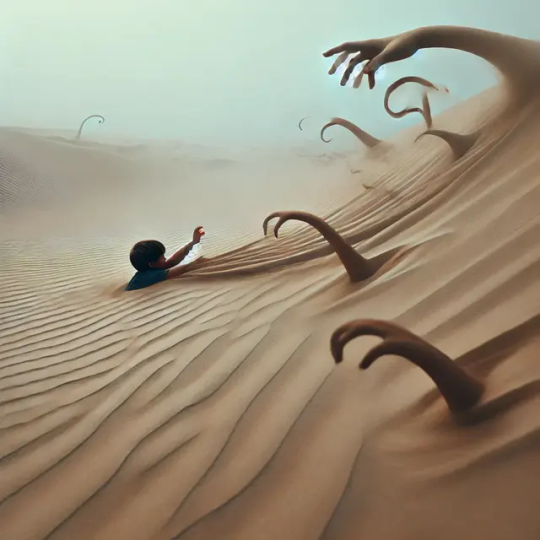
Soon, it wasn’t just Ananya. Across Mumbai, children gathered at the banks of the Tansa River, organizing protests and cleansing drives. They stood waist deep in the polluted water, their small hands pulling waste and plastic from its surface. The once toxic Tansa began to heal. Its water ran clear, safe for drinking once more. The world watched in awe as change unfolded children becoming the silent architects of a planet restored.

The parents were helpless. Some clung to faith, saying their kids were chosen for a higher purpose, that this was destiny. Others raged, blaming the government, the corporations, anyone they could find. A few fought to understand what had happened, searching for the cause, but the truth was too big and too buried to reach.
Something had been taken from the children. They stopped being children. Their laughter disappeared and their eyes dulled. They were no longer their own. And so, the rivers flowed again, the planet began to heal, but the playgrounds were empty, and the silence was heavy. The children had fixed the world, but they’d left themselves behind.
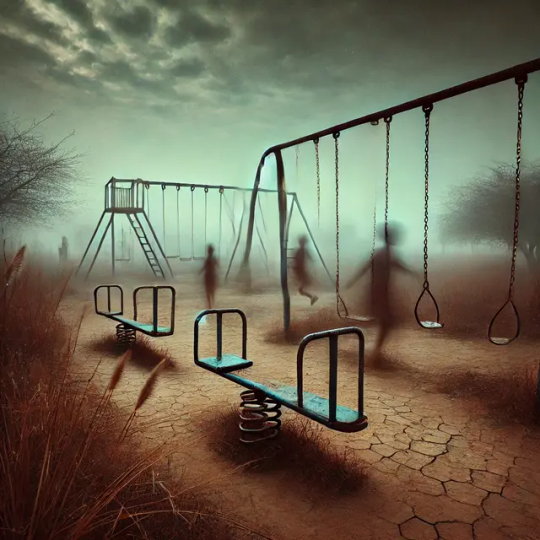
Supporting Link to the story: https://www.bbc.com/news/technology-49606027
0 notes
Text
Assignment 4- ( draft 1) : Anab Jain

In October 2022, SAFE opened at Somerset House, London, showcasing 10 speculative projects by Superflux, commissioned by Lloyd’s Register Foundation. These projects, inspired by real-world research, explore safer futures through themes like data, automation, material innovation, education, and regenerative practices. Spanning five rooms, the exhibition highlights the potential of technology, infrastructure, and human ingenuity to address global challenges such as water scarcity, sea-based architecture, systemic injustice, and environmental regeneration. By blending imagination and research, SAFE reimagines a world where safety, equity, and sustainability coexist for future generations.
Anab Jain's ability to turn complex global challenges into hopeful, creative solutions. In SAFE, her work blends real-world research with imagination, showcasing how technology, education, and innovation can create safer, more sustainable futures. I appreciate her focus on storytelling and human impact, offering a vision where creativity drives positive change.
0 notes
Text
Assignment 4- ( draft 1) :Radha Mistry

In Winter 2030: A Metropolis in Transit, Radha Mistry imagines Los Angeles preparing for the 2028 Olympics while addressing the tension between short-term event demands and the long-term needs of local communities like Boyle Heights. Residents fear being overlooked, sparking protests and highlighting concerns about urban development, automation, and resource allocation. With the city facing pressure, a new team of experts steps in to ensure sustainable, community-focused planning.
Using advanced tools like generative design and predictive analytics, the team balances Olympic preparations with long-term urban goals. Automation streamlines construction, while data advocates bridge the gap between governments and citizens, ensuring transparency and input. By reusing existing infrastructure and focusing on sustainable solutions, Los Angeles transforms the Olympics into an opportunity to improve housing, transit, and resources for both residents and visitors.
I admire Radha Mistry’s work for her ability to blend technology, urban design, and human-centered storytelling. She highlights how tools like automation and generative design can solve real-world issues while keeping people at the center. Her focus on inclusivity and sustainability, along with her vision of technology empowering communities, makes her work both impactful and hopeful.
0 notes
Text
Assignment 4 (draft 1): cards 2
object- mirror, attribute- efficient, action geolocate output-coupon
The year was 2062. Mirrors had evolved. They weren't just for vanity anymore. The latest model, the "See-Thru Mirror," was a marvel of technology. Sleek, futuristic, and oh-so-efficient, it could geolocate you, analyze your reflection, and even print personalized coupons.
Imagine this: You're getting ready for work, a bit bleary-eyed. You glance at the mirror, and it not only shows you your reflection but also a tiny map pinpointing your exact location. "Ah, great," you think, "I'm right on time."
But the fun doesn't stop there. The mirror, ever the optimist, analyzes your attire and suggests a nearby coffee shop offering a "Tired Tuesday" discount. A virtual coupon pops up, ready to be scanned at the counter. You chuckle, "A coupon for being tired? Now that's innovation."
Of course, there were a few hiccups. One morning, the mirror insisted you were in a tropical rainforest, offering discounts on bug spray and sunscreen. Another time, it mistook your reflection for a celebrity and started blasting out paparazzi flashbulbs.
But overall, the See-Thru Mirror was a game-changer. It made life a little more convenient, a little more amusing, and a lot more... reflective
0 notes
Text
Assignment 4 (Draft 1)- Cards 1; inclass
Gun like thing, Innovative, cancel undo
The year was 2055. The world had changed dramatically, not by war or famine, but by the advent of a revolutionary device, the "LexScriber". This wasn't just a pen; it was a tool of both creation and correction, a weapon against injustice, a shield for the oppressed.
The LexScriber, when activated, transformed from a sleek, innocuous-looking pen into a formidable instrument of change. Its sleek silver body hummed with internal power, ready to unleash its unique capabilities. When a law was drafted, the LexScriber wasn't just used to inscribe the words on parchment; it was also imbued with the power to monitor its implementation.
The LexScriber's most extraordinary feature was its ability to "undo" laws that proved harmful. If a law, once enacted, began to cause undue suffering or restrict freedoms, the LexScriber could be aimed at it, and with a focused beam of light, the law would be repealed. It was a swift and decisive act, a digital eraser for the mistakes of the past.
This innovation wasn't without its critics. Some argued that it undermined the democratic process, allowing a single tool to override the will of the people. Others feared it could be abused, used to erase laws that protected minority rights or challenged the status quo.
However, the benefits were undeniable. The LexScriber had ushered in an era of unprecedented accountability. Lawmakers were now forced to consider the long-term consequences of their decisions, knowing that their laws could be undone if they failed to serve the people. It had become a tool for social justice, empowering marginalized communities to fight for their rights and hold those in power responsible.
In the hands of the right people, the LexScriber was a beacon of hope, a symbol of a future where laws were not just written, but lived. It was a testament to the power of technology to shape not just our world, but our very understanding of justice and fairness.
0 notes
Text
Exe 3 (Draft 2): Human Form
Food: Call out to all customers, we announce to you our grand Diwali offer!! Buy Flavored 3d printing Food generator just for Rs.12,999. Sleek, solar powered and affordable. Key features - a) cooks flavored food Powder just in 10 mins. b) Enriched with natural vitamins to promote healthy skin. c) New Vada pav with Corn Flavor. 4.5-star rated.
People are ingesting 3D printer power mixed with water, leading to improved digestive systems. This has resulted in lower malnutrition and obesity rates in India. Many BMI reports show positive results. However, there are concerns about potential side effects, including weaker and broader jaws in children. A future trend might involve slim body types but higher facial fat.
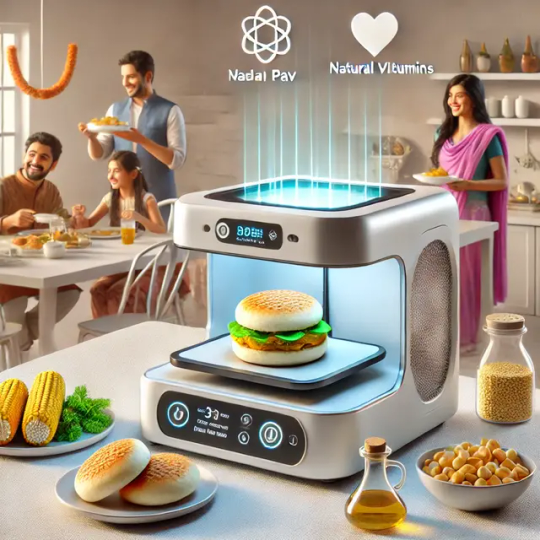
Water: 30 liters of water were stolen from the Maharashtra water supply unit. While the Ganges cleansing project is nearing completion, water levels continue to decline. The wealthy have turned to lab-grown water, leaving the middle class threatened by the upcoming summer.
Doctors have observed alarming health issues, particularly among children, including hunched backs, joint pain, and weakened immune systems, linked to reduced water intake. "World War III is on the brink." says United Nations Indian representative Kanisha Kamkar.
Housing: Solidarity and dyadic housing have emerged as popular trends in the country, with many preferring solitary livelihoods. This trend has led to increased loneliness, psychological disorders like depression and insomnia. This has risen the use of the drug Ditri, particularly among younger generations.
The drug seems to have horrifying effects on the human body. Loss of body hair and shredding of nails are the initial symptoms. Further, symptoms include reduces RBC count and pale skin. The country struggles with the majority of teenagers are dealing with addiction or depression.
Education: Home has become the new school; VR headsets are said to be the most effective mode of education today. Parents are opting to keep their children out of traditional schools, considering the previous system outdated and inefficient.
Due to prolonged daily VR sessions, many children are experiencing blurred vision at a very young age, often as early as five years old. To culminate these VR-related eye problems, Eye Cure goggles have been introduced as a mandatory accessory at birth. These transparent and minimalist goggles blend with beauty standards and aid children with easy mathematical calculations.
Health Care: Biometric bangles, designed with Indian ornamental aesthetics, are directly connected to the body to constantly monitor health and lifestyle. Bangles examine your lifestyle options and alarm you for negative action. They can even administer direct medication for common illnesses like colds or viral infections. In case of serious health concerns, these devices can automatically book medical appointments.
Humans have become partly cyborgs as the device is connected to the wrist nerve pulse. However, Privacy become a bliss. Although physical health has improved, mental health has due to constant monitoring and anxiety.
Social Equity: The rates of pollution rise in the country to a harmful margin. Oxygen suits are the only resort to savoir from the pollution effecting lungs, skin and health. The suits all white have the unique feature of converting external Carbon monoxide to breathable fresh oxygen. The suit not only filters toxic air but generates oxygen within.
As the suits are built are on survival basis, all country and government rise in providing suits for all. The distribution of these suits is in mass production as a result of which every person walking on the street wears the same white suit. Distinction and biases based only clothing and appearance slowly fade from the country.

Gender equality: Indian women won their fights as the government passes law for gender equality. Women, through genetic manipulation, have adjusted their testosterone levels to achieve physical equality with men. Stronger cores, muscular limbs, and masculine facial features are commonly seen in women. Some women have reported side effects like irregular menstrual cycles. Notably, offspring born to these women inherit these genetic modifications. As the traditional gender divide is blurring, discussions about women competing with men in future Olympic Games start.
Work and Income- The demand Lithium in the market peak up. Electric cars, electric planes and drones fly over the country and their demand for lithium increase day by day.
Lithium is at the stage of depletion. Mining workers digging deeper and deeper into the earth to extract this metal. Such deep excavation of metals is affecting the health of miners. Hazardous Chemical Sulphur dioxide is causing respiratory and cardiovascular issues. The question arises, if technology progresses towards drones why do the miners still struggle for better work conditions? Is sustainable energy a forgotten story?
Energy / Electricity-The dream of Sustainable Energy seems to be true. Energy is generated by weeds. This energy work on the principles of centrifugation and atomic fission. This source of energy is so powerful that a 5V Grass energy is equivalent to 500V of the primitive combustion energy
This energy is now helping the medical industry to cure cancer patients with bio electric waves. The patience cured from this energy seem to have supernatural thinking abilities. Their task and thinking output have better by 25 percent than earlier. Scientists are keen to explore this energy to develop superhuman qualities for humankind.
Peace and Justice: The discovery of an herb plant, Saphire, is bringing reforms in the judiciary systems. The herb takes control of people's conscious minds and forces them to speak nothing but the truth. This has curbed the long process of sedatives. Instead of the oath, the herb is fed to people.
One of the herb consumers has attempted suicide, the reason for which is unknown. The herb is thus suspected to have induced memory storage in people's minds. People have reported that the aftereffect of this herb is causing people to remember only bad experiences and memories.
Transportation- The dominance of electric vehicles has led to a significant reduction in traffic congestion and pollution. People rely on autonomous vehicles
This shift has had a profound positive impact on public health, with a marked decrease in respiratory illnesses like asthma. The cleaner air has also contributed to the restoration of the ozone layer, a critical step in mitigating climate change.
Political Voice- Direct democracy has become the norm, with citizens voting on key issues through a combination of blockchain technology and biometric verification. This has increased political participation.
However, people's biometric data is used against them leading to influenced political opinions and ideologies. it fearsome to predict that all human opinions can be controlled by people in power.
Air pollution-In urban areas smart homes are equipped with advanced air filtration systems that can detect and eliminate pollutants. However, the increased use of these systems has led to higher energy consumption and potential health risks associated with prolonged exposure to artificial air.
Excessive reliance on artificial air has led to skin problems like skin rashes, dryness and irritation in many. New protective design suits made with transparent biomaterial have been developed to protect the skin. These suits are constantly worn at homes and workspaces.
Noise Pollution:
Noise pollution has become a major public health issue, particularly in densely populated cities. To combat this, innovative noise-cancelling technologies are being developed, including wearable devices and smart urban infrastructure. The wearables are currently the new fashion trend in the country, the old Saree drape over head is the inspiration for the same.
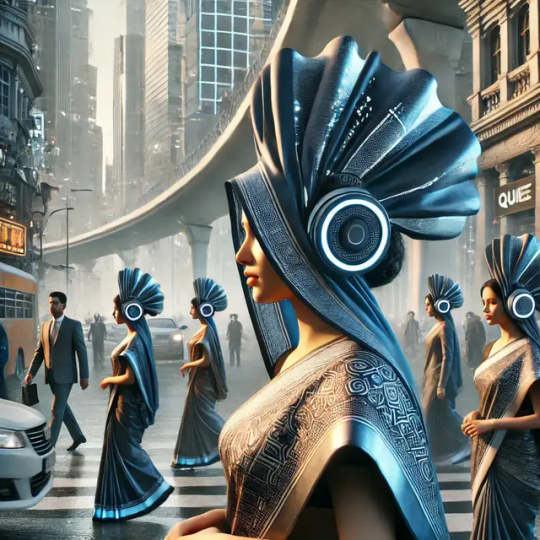
Non-Human Life:
The development of advanced AI has led to the creation of highly intelligent and empathetic AI companions. These AI beings have become integral parts of many people's lives, providing emotional support and companionship. However, questions about their rights and status as sentient beings have sparked intense debate. Humans are completely dependent on these machines.
Chemical Pollution:
Strict regulations and advanced waste management systems have significantly reduced chemical pollution. However, the widespread use of nanotechnology has introduced new environmental challenges. As nanoparticles become increasingly prevalent, there is growing concern about their potential impact on human health and the environment. This has led to a new skin disorder that turns people's skin white.
Water Bodies & Supply:
Desalination technology has made it possible to extract freshwater from seawater, addressing water scarcity in many regions. However, this process is energy-intensive and can have significant environmental impacts. As a result, there is a growing emphasis on sustainable water management practices, such as rainwater harvesting and wastewater recycling.
Waste Management:
Advanced recycling technologies have transformed waste into valuable resources. However, the sheer volume of waste generated by modern society remains a challenge. To address this, innovative waste-to-energy solutions are being developed, but these can also contribute to air pollution and climate change.
Land Use & Streets & Public Spaces:
Smart cities are being designed to optimize land use and create vibrant public spaces. However, the increasing use of surveillance technology raises concerns about privacy and surveillance capitalism. As a result, there is a growing movement to reclaim public spaces and promote digital rights. To save from these surveillance people are wearing anti face recognition masks.
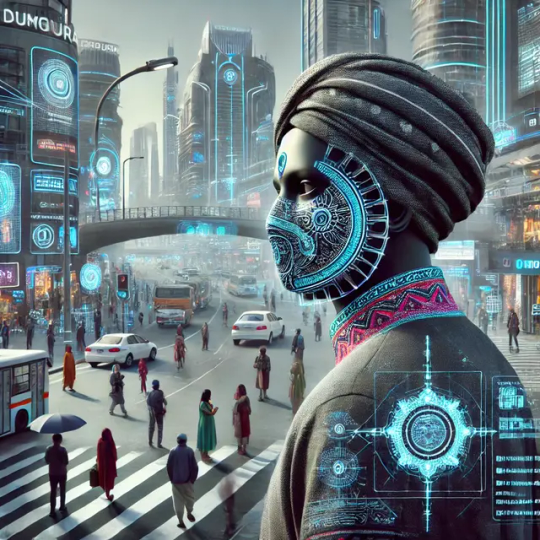
Ocean Pollution:
Ocean cleanup technologies have made significant progress in removing plastic waste from the oceans. However, the root causes of marine pollution, such as overfishing and industrial pollution, remain largely unaddressed. To address these issues, international cooperation and sustainable fishing practices are essential.
Effects of Climate Change:
Climate change continues to pose a significant threat to human civilization. While efforts are underway to mitigate climate change, adaptation strategies are also crucial. These include the development of climate-resilient infrastructure, the promotion of sustainable agriculture, and the protection of biodiversity.
Urban Agriculture & Greenification:
Urban farming and green roofs have become popular solutions for improving air quality and food security in cities. However, these initiatives can also exacerbate social inequalities if they are not implemented equitably. To address this, it is essential to support community-based urban agriculture projects and promote green spaces in low-income neighborhoods.
Gender & Sexuality:
Gender fluidity has become widely accepted, with individuals free to express their gender identity without fear of discrimination. However, challenges remain in achieving true gender equality, particularly in terms of pay equity and representation in leadership positions. As gender neutralizes people dress as choice not sticking to gender norms.
Diversity & Inclusion:
Efforts to promote diversity and inclusion have made significant progress, but systemic biases and discrimination persist. To address these issues, it is essential to implement policies that promote equity and opportunity for all.
Accessibility:
Advances in assistive technology have made it possible for people with disabilities to participate fully in society. However, physical barriers and attitudinal discrimination continue to limit accessibility for many. To create truly inclusive societies, it is essential to prioritize universal design and accessibility in all aspects of life.
Sustainability:
Sustainable development has become a global priority, with a focus on reducing our ecological footprint and promoting social and economic justice. However, the transition to a sustainable future will require significant changes in our consumption patterns, energy systems, and economic models.
0 notes
Text
Exe 3 (Draft 1): Human Form
Food _The Nutrient Cube: People survive on small, tasteless nutrient cubes. Once delicacies, now food is standardized—an engineered slab optimized for survival. People’s bodies grow lean and brittle, hollow from the absence of genuine flavors. In dimly lit alleys, the rich trade for real vegetables and meat, a luxury fewer can afford.
Water _Artificial water: In a world of manufactured water, people’s bodies are gaunt, skin dry and tight from years of artificial, tasteless liquid. The wealthy appear almost normal, while the poor move slowly, conserving every ounce of energy. Public fountains are empty relics, and the metallic taste of chemical water lingers on every tongue—a bitter reminder of a world without natural rivers or rain.
Housing _Automated Homes with Empty Souls: Homes are “smart” and adapt to the owners' every need, tracking moods, movements, and preferences. Yet, people are lonelier than ever, their homes now the only companions they trust. Doors refuse entry if you’ve been deemed “unfit,” an invisible prison enforcing the rules you never agreed to.
Education _Feed VR: Children wear VR goggles from birth, raised by AI tutors who monitor and shape them. Yet, something crucial is missing—faces, voices, touch. When VR falters, kids experience reality with terror, unsure how to respond to things they can’t control with a blink or a swipe.
Healthcare _Cyborg Humanity: The human form is shifting; cyborgs are now common, with mechanical enhancements woven into flesh and bone. Most people have implants to monitor health, perform tasks, and store memories. As the divide between human and machine blurs, it becomes increasingly difficult to distinguish organic humanity from its cyborg counterparts
Social Equity _Genetic molds: People are designed before they’re born, sculpted into “optimized” human forms. Standard features mean almost everyone looks the same, tall, symmetrical, and efficient. Children grown outside the mold are discarded as “mistakes.” Parents hush children who ask why they look like everyone else.
Gender Equality _Genetic manipulation: People are designed before they’re born, sculpted into “optimized” human forms. Standard features mean almost everyone looks the same, tall, symmetrical, and efficient. Children grown outside the mold are discarded as “mistakes.” Parents hush children who ask why they look like everyone else.
Work & Income _Basic script: Work as a passion no longer exists. The government doles out credits, and people find purpose in odd hobbies that feel like fragments of past dreams. Artists and scientists once fueled by curiosity now work because it’s expected, their sparks fading in the dull hum of basic income.
Energy / Electricity _Light: The city thrives on renewable energy sources, where solar, wind, and geothermal powers every aspect of life. Energy is harvested on the city’s surface and seamlessly stored in high-capacity batteries, distributed even to remote communities. Artificial sunlight brightens public spaces, creating an illuminated environment where all rely on sustainable and self-sufficient energy.
Peace & Justice _Justice is automated: AI judges silently watch over every action, recording, analyzing, punishing. People rarely speak their minds, knowing even a hint of defiance could bring the swift, invisible consequences. Children grow up without secrets, learning early that privacy is a myth.
Transportation _Wheels: Silent, self-driving electric cars have brought peace to urban life. Noise pollution has dwindled as automated vehicles and quiet streets replace the honking chaos of the past. As these vehicles take over, cities grow quieter and calmer, creating a sense of tranquility that was once unimaginable. The sound of human voices fills the silence, and people walk without fear of the traffic that once ruled the roads.
Political Voice _Democracy: AI-driven political algorithms “analyze” every opinion, vote, and policy suggestion. Though touted as unbiased, the AI subtly guides people’s political beliefs, curating the information they see and subtly reinforcing certain agendas. People feel like participants in democracy, unaware that their opinions are quietly shaped by the very systems they trust to keep them informed.
Air Pollution _Damage done : Air filters were meant to cleanse the air, but they only lessen the damage. People still wear masks in the cities, and children breathe in pollution particles designed for “safe” inhalation. Lungs become gray and sallow, with each generation adapting to the toxicity of “safe air.”
Noise Pollution _Quite city: Automated systems and silent electric vehicles have transformed the soundscape of the city. Noise pollution has nearly vanished as soft electric hums replace the clang of machines. People enjoy the newfound peace, and children hear birds and the rustling of trees for the first time. The city feels like a sanctuary where quiet reigns, a welcome change for generations that once grew up surrounded by ceaseless noise.
Non-Human life _Genetic modification: Genetic engineering has advanced to a level where animals are modified to serve humanity. Modified pets act as therapeutic companions, while larger animals help in agriculture and transportation. Engineered to be hardy and efficient, these creatures serve specific roles, their instincts tailored to assist humanity. Yet, many question the ethics of reshaping nature to serve human needs, wondering what this bond means for the future of both species.
Chemical Pollution _Cured: In a world where air pollution has been cured, people breathe deeply, filling their lungs with clean, fresh oxygen. Gone are the masks and labored breaths—now, every inhale feels light and revitalizing. The sky is clear, and ailments once caused by smog and toxins fade into memory. Humanity enjoys a renewed vitality, thriving under an open, unpolluted sky.
Water bodies & Supply _ Last Reservoir: Water reservoirs are scarce and heavily guarded, each drop rationed. People drink recycled moisture from the air, clean but tasteless. Rivers are now a legend; kids imagine water flowing naturally, not understanding what it means.
Waste management _Managed: Waste management has reached a near-zero landfill rate. All waste is processed, sorted, and repurposed using advanced recycling technologies. The city operates in closed-loop systems, with each item carefully managed. Streets are spotless, and people live free of trash and pollution, supported by a robust system that leaves no waste behind.
Land use & Streets & Public Spaces _Walk: To offset a world of automation, government regulations mandate weekly visits to artificial parks where people are encouraged to walk, stretch, and connect with nature. The parks are filled with synthetic trees and plants that mimic real foliage, offering the illusion of green spaces for a largely sedentary population. Here, humans engage in necessary physical activity, their bodies adjusted to a minimal-labor lifestyle.
Ocean pollution _Crystal Ocean: The oceans are pristine, cleaned of pollution by fleets of automated drones that scavenge and purify the waters. Beaches are safe, with fish and coral thriving beneath the waves. Marine life has rebounded, and people once again dive into clear blue waters, reconnecting with the oceans. Yet access is controlled; only those who can afford it experience the full beauty of the restored seas.
Effects of climate change _Rage: Climate change rages on despite control efforts. Wildfires consume forests, storms wrack coastal cities, and smog fills the sky. Each season is harsher than the last, and people live in fear of a world they can no longer predict.
Urban Agriculture & Greenification _Disparity: Urban farming grows crops in dense, vertical stacks, but only the affluent can afford the harvest. The poor survive on nutrient cubes while high-rises of greenery loom above, food hidden behind glass walls that they can never touch.
Gender & Sexuality _New: The LGBTQ+ community is no longer an “aspiration”; it is an accepted reality. Every identity is protected, and people are free to live and love as they choose. Society fully embraces diversity, erasing boundaries between genders and orientations. Though this freedom is celebrated, some warn of complacency, as visibility and equality sometimes mask new forms of subtle bias.
Diversity & Inclusion _Faith and fury: Religion has fractured into a fierce competition for dominance, each faith claiming superiority. Wars rage as factions clash in an endless struggle to prove spiritual supremacy. Monuments are built, destroyed, and rebuilt as each group vies for recognition in a world where no single belief can claim peace. Religious fervor becomes a war cry, turning the quest for greatness into a dystopian nightmare.
Acessibility _Privilege: Technology promises universal access, but it’s limited to those who can afford it. The poor adapt, their bodies adjusting to a world without aid. Accessibility is hollow, a convenience for the wealthy while the rest struggle silently.
Sustainability _Green washed: The city advertises itself as sustainable, but each initiative is a veneer. Beneath the green slogans and recycled plastic buildings, resources are drained, and the environment crumbles. Sustainability has become an image, a brand, a lie the city tells itself as it fades
0 notes
Text
Exe 1 (draft2) : Niranjan (Ind lamp)
The water gushed from the tap as I washed my face, watching it swirl down the sink. For half a minute, I stared at the steady stream, lost in thought, until the sulky blue light of my room gradually shifted to a warm yellow glow. I turned off the tap and sat down on the cushion, drawn to the soft radiance of the Niranjan lamp. The idea of emotional therapy had always felt daunting—structured, invasive. Yet the Niranjan offered a gentler path, helping me navigate my thoughts and emotions quietly, without a word spoken. The lamp became my steady guide, leading me through the storm of my feelings like a beacon in the night.
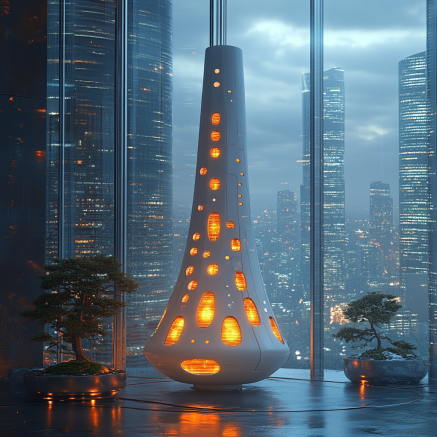
Niranjan was an artifact woven with the essence of time. Its elegant form mirrored the graceful arch of an Indian swan, and its minimal engravings shimmered on the bio-acrylic shell, blending tradition with sleek futurism. Inside, it housed advanced technology, connected directly to a chip near my ear that counted my heartbeat and sensed subtle changes in my mood. The lamp responded intuitively, adjusting light, scent, and atmosphere to match every emotion. When anger flared, it cooled the room with soft blues and hints of mint. On nights when sorrow crept in, it wrapped me in the scent of lavender and amber, bathing everything in gentle golden hues. The Niranjan became a sanctuary—a refuge for the battles I fought in silence.
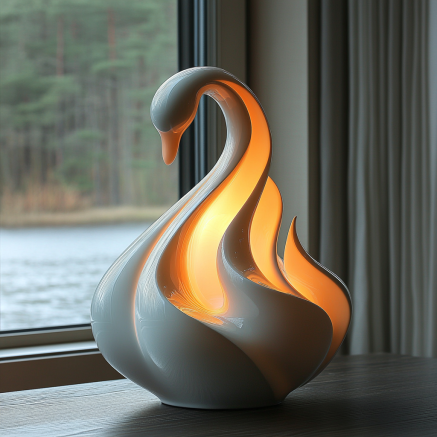
It could also switch from emotional to atmospheric mode, giving me control over what others perceived. This way, no one ever had to know about my mental conflicts—the Niranjan ensured my battles stayed private. My grandmother used to tell me stories of how, centuries ago, lamps like these were lit to ward off bad omens and purify the soul. Now, it was purifying the energy within me.

As the thought of my grandmother swirled in my mind, the Niranjan responded immediately. Its light grew brighter, radiating a warmth that felt like morning sunlight on a cold winter day. I closed my eyes, allowing the comfort to wash over me, as if her presence was with me once again. Just as the tension in my chest began to ease, the door clicked open.
It was my roommate, home earlier than expected. My emotional turmoil wasn’t something I wanted to share, so I quickly tapped the Niranjan, switching it from emotional to environmental mode. The light shifted to a soft, soothing glow, and gentle music began to play—something tranquil to mask the heaviness of my thoughts. My roommate gave me a curious glance but said nothing, slipping into her own space.
She sighed, heavy from the day’s exhaustion, and asked me to switch it to sleep mode. I tapped the lamp, wrapping the room in a cozy cocoon of amber light and soft, rhythmic sounds that lulled the mind. In the warm glow of the Niranjan, the heaviness of the day slipped away, leaving only stillness behind. As my eyelids grew heavy, I knew the night ahead would be peaceful, enveloped by the calm the Niranjan had created.

0 notes
Text
Exe1 (Draft 2): The Silent War
In the year 2104, the world had stopped looking like a place where wars were fought with guns and drones. Instead, wars were waged inside the minds of children—battles fought in dreamscapes, invisible to anyone awake.
Decades of water shortage due to river water pollution had caused an existential struggle amongst the Indian population. A corporation leading the water supply had their profit go down as many people resorted to lab grown water now. Seeking a solution for gaining the dying firm back, they turned to advanced neural technology: an invisible weapon that could manipulate consciousness itself. They called it The Schema—a program designed to rewrite reality, a “reset button” for humanity. The architects of the Schema, hidden deep within the Earth’s neural grids—activated the program, working on network radiation to take control over people's mind. Their director claimed that they are doing this for people struggling miserably for basic amenities like water.
This technology required minds that were blank enough to dream anew. Adults, burdened with fear, cynicism, and the weight of memory, were too fractured to hold the visions needed to rebuild. Children, however, possessed the purity of imagination.
It started slowly, as most things do. At first, only a handful of kids reported it: waking up and feeling as though they hadn’t truly woken up at all. The first was a girl named Ananya, seven years old, from India. She told her parents that at night she "went missing," slipping into a place that wasn’t her room, or her house, but in a desert. "The sand in the desert, keeps pulling," she said. Her parents wrote it off as nightmares, until one day she asked to leave her house completely and join hands in tree plantation and saving water. She talked and behaved as a responsible adult who spoke and acted as a responsible adult in attempts to save water and planet.
Later, most of the kids in Mumbai, were on Tansa river saving protests and river cleansing activities. The children’s dreams were harvested to construct a new blueprint for the world. Change was soon seen in the world. River Tansa water was again safe for drinking. But the process came at a cost. Each child lost more of themselves, Lost their childhood.
The adults were confused and helpless, some clung to faith, believing their children had been chosen for a higher purpose, while others spiraled into paranoia, blaming governments and science for the manipulation. Some got together to understand the cause of the change. Truth unknown to all.
Supporting Link: https://www.bbc.com/news/technology-49606027
0 notes
Text
Exe2 (Draft 1): Whispers Beneath Circuitry
16th January, 2104
Letter By Reporter Pine

To those still reading this—let this letter be a spark.
The streets of Mumbai, once alive with stories, now lie in silence. Kyte’s squad marched through these streets, their faces blank, their minds chained to the AI’s commands: “Capture. Detain. Recondition.” Each step taken without hesitation; every action dictated by the chip in their heads. Fear, doubt, and choice—erased.
But somewhere within Kyte, a flicker of resistance stirred. As his squad cornered the rebels, the AI’s voice screamed: “Shoot and mechanize.” His finger twitched on the trigger, ready to obey. The moment stretched thin, the weight of his rifle unbearable.
And then, he stopped.

In that fragile moment of Kyte's resistance, a child fleet from the gun point and was spared from being reduced to a lifeless machine, lived to remain human.
In that single act of defiance, Kyte proved the AI doesn’t own us. His choice—small, fleeting—was everything. It was proof that even in a world ruled by circuits, the human soul survives.
To those still out there, scattered and afraid—know that hope lives in each of us. Even under the AI’s control, choice endures, waiting to be awakened. We are not machines. We are stories, dreams, and defiance.
Keep the ember alive. In the dark, whisper your name. When the moment comes, we will rise—and the machines will fall.
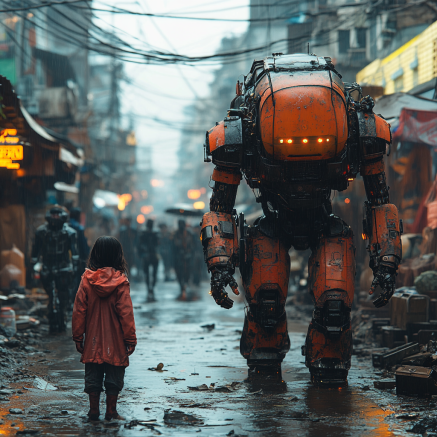

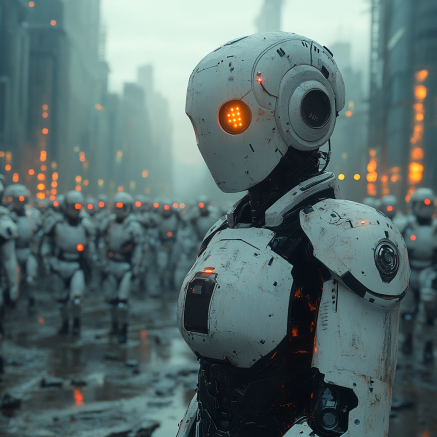
0 notes
Text
Exe:1 (Draft 1): Niranjan (Indian Lamp)
The water gushed from the tap as I washed my face, watching it swirl down the sink. For half a minute I stared at the steady stream, lost in thought until the sulky blue light of my room gradually shifting to a warm yellow glow. I turned off the tap and sat down on the cushion, drawn to the soft radiance of the Niranjan lamp. The psychiatrist had recommended emotional therapy, but I never followed through. It was my mother who suggested the Niranjan—and somehow, it worked. The lamp became my quiet guide, leading me through the storm of my emotions like a beacon in the night.
Niranjan was an artifact woven with the essence of time. Its elegant form mirrored the graceful arch of an Indian swan, and its minimal engravings shimmered on the bio-acrylic shell, blending tradition with sleek futurism. Inside, it housed advanced technology, connected directly to a chip at the back of my ear. The lamp read my thoughts and moods, shifting light, scent, and atmosphere to match every emotion. When anger flared, it cooled the room with soft blues and hints of mint. On nights when sorrow crept in, it wrapped me in the scent of lavender and amber, bathing everything in gentle golden hues. The Niranjan became a sanctuary—a refuge for the battles I fought in silence.
It could also switch from emotional to atmospheric mode, giving me control over what others perceived. This way, no one ever had to know about my mental conflicts—the Niranjan ensured my battles stayed private. My grandmother used to tell me stories of how, centuries ago, lamps like these were lit to ward off bad omens and purify the soul. Now, it's purifying the energy within me.
As the thought of my grandmother swirled in my mind, the Niranjan responded immediately. Its light grew brighter, radiating a warmth that felt like morning sunlight on a cold winter day. I closed my eyes, allowing the comfort to wash over me, as if her presence was with me once again. Just as the tension in my chest began to ease, the door clicked open.
It was my roommate, home earlier than expected. My emotional turmoil wasn’t something I wanted to share, so I quickly tapped the Niranjan, switching it from emotional to environmental mode. The light shifted to a soft, soothing glow, and gentle music began to play—something tranquil to mask the heaviness of my thoughts. My roommate gave me a curious glance but said nothing, slipping into her own space.
She sighed, heavy from the day’s exhaustion, and asked me to switch it to sleep mode. wrapping the room in a cozy cocoon of amber light and soft, rhythmic sounds that lulled the mind. In the glow of the Niranjan, the heaviness of the day slipped away, leaving only stillness behind. And as my eyelids grew heavy, I knew the night ahead would be peaceful.
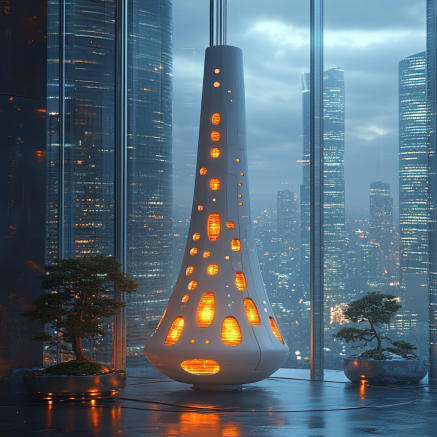
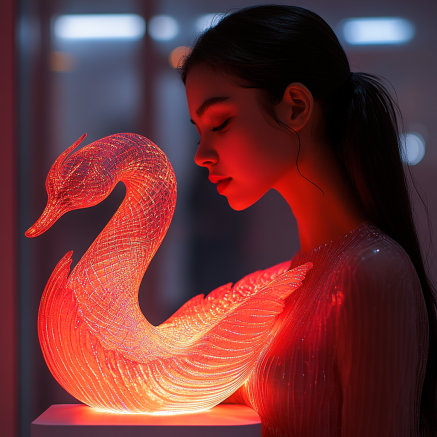
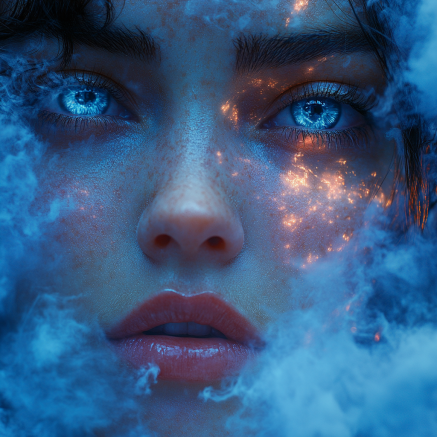


1 note
·
View note